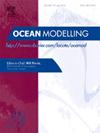Transit time of deep and intermediate waters in the Gulf of St. Lawrence
IF 2.9
3区 地球科学
Q2 METEOROLOGY & ATMOSPHERIC SCIENCES
引用次数: 0
Abstract
The transit time of the subsurface waters in the hypoxic and acidified Gulf of St. Lawrence (GSL) is poorly understood, despite its strong influence on physical and biogeochemical water properties. Three estimates of the transit time of the deep waters between Cabot Strait and the head of the Laurentian Channel, a deep channel cutting through the GSL, have been published up to now. Here, using lagrangian tracking experiments in a regional ocean model, we provide a new estimate of the transit time in the deep layer (> 225 m) of the GSL, as well as the first estimate of the transit time in the intermediate layer (50–175 m). Our estimate for the deep layer is 3.2 ± 0.7 years. The transit time in the intermediate layer (1.2 ± 0.5 years) is nearly three times faster than in the deep layer. The deep waters travel mainly up the Laurentian Channel, whereas most of the intermediate waters first transit through the Esquiman and /or Anticosti Channels. Our results also highlighted the impact of the seasonal changes in large-scale circulation on the transit times of the particles seeded at Cabot Strait. In summer and fall, the circulation is relaxed, and subsurface waters transit slowly but more directly upstream, leading to faster transit times. In winter and spring, the circulation is intensified but many particles get caught in large gyres prevalent during these seasons, leading to slower average transit times.
圣劳伦斯湾深水和中水的穿越时间
低氧酸化的圣劳伦斯湾(Gulf of St. Lawrence, GSL)地下水的运移时间对水体的物理和生物地球化学性质有很大影响,但人们对其了解甚少。迄今为止,关于卡伯特海峡和穿过GSL的劳伦森海峡(Laurentian Channel)的深水通过时间的估计已经发表了三次。在此,我们利用区域海洋模型中的拉格朗日跟踪实验,提供了深层传输时间的新估计(>;在GSL (50 ~ 175 m)的第一次估算中,我们估计深层的传输时间为3.2±0.7年。中间层的过境时间(1.2±0.5年)比深层快近3倍。深水主要沿劳伦海峡而上,而大部分中间水域首先通过爱斯基曼海峡和/或安提科斯蒂海峡。我们的研究结果还强调了大尺度环流的季节变化对在卡伯特海峡播种的粒子过境时间的影响。在夏秋两季,环流较为松弛,地下水流速较慢,但更直接地向上游移动,因此流速较快。在冬季和春季,环流加强,但许多颗粒被困在这些季节普遍存在的大环流中,导致平均过境时间较慢。
本文章由计算机程序翻译,如有差异,请以英文原文为准。
求助全文
约1分钟内获得全文
求助全文
来源期刊

Ocean Modelling
地学-海洋学
CiteScore
5.50
自引率
9.40%
发文量
86
审稿时长
19.6 weeks
期刊介绍:
The main objective of Ocean Modelling is to provide rapid communication between those interested in ocean modelling, whether through direct observation, or through analytical, numerical or laboratory models, and including interactions between physical and biogeochemical or biological phenomena. Because of the intimate links between ocean and atmosphere, involvement of scientists interested in influences of either medium on the other is welcome. The journal has a wide scope and includes ocean-atmosphere interaction in various forms as well as pure ocean results. In addition to primary peer-reviewed papers, the journal provides review papers, preliminary communications, and discussions.
 求助内容:
求助内容: 应助结果提醒方式:
应助结果提醒方式:


